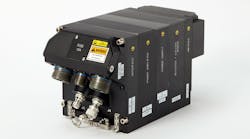Communications security can mean the difference between success and failure in battle. Rockwell Collins has taken a major step in fortifying the security of its airborne radios by developing the first airborne VHF/UHF radio that meets the military security requirements for the U.S. Department of Defense (DoD) Mobile User Objective System (MUOS). Rockwell Collins’ sixth-generation ARC-210RT-2036(C) VHF/UHF radio recently passed Do Not Harm (DNH) testing performed by the Space and Naval Warfare Systems Command (SPAWAR) using the most current MUOS test signal waveforms.
The ARC-210RT-2036(C) secure military radio (see figure) provides total frequency coverage of 30 to 1850 MHz, spanning VHF, UHF, and L-band frequencies. It provides a variety of channel bandwidths, as wide as 30 MHz and as fine as 5 kHz, with the capability to perform software-defined-radio (SDR) channel tuning in 1.25- or 8.33-kHz increments. The versatile and secure military radio features a wide range of waveform options, including SINCGARS, Soldier Radio Waveform (SRW), and Joint Precision Approach and Landing System (JPALS) waveforms.
“We’re at the forefront of this new technology and one step closer to bringing certified MUOS capability to airborne operations,” said Troy Brunk, vice president and general manager, Communication, Navigation, and Electronic Warfare Solutions for Rockwell Collins. “The benefits of MUOS, which include improved mobility, frequency capacity, access and signal quality, will provide the communications our warfighters need for continued success in the future.”
The MUOS satellite communications (satcom) system is used by the DoD for air and ground communications, extending to the UHF range for increased capacity and signal quality. It allows troops to access any combination of voice, video, or data with the assurance that information is not being blocked or intercepted. The ARC-210 RT-2036(C) radio, which performs well in rough terrain and beyond-line-of-sight operating conditions, started with MUOS testing in 2013. For the U.S. Air Force, the first MUOS-certified ARC-210 RT-2036(C) radio will be installed aboard an F-16 fighter.

